6 easy ways to connect your guitar to your iPhone, iPad or iPod touch
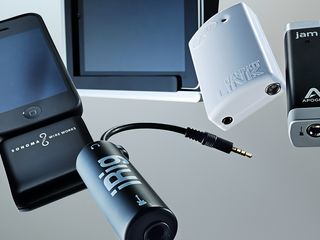
6 easy ways to connect your guitar to your iPhone, iPad or iPod touch
Many of us have iPhones, some of us have iPads, and it can’t have escaped your attention that there are many apps available for iOS devices aimed at guitarists.
From the simplest tuner, to tab and tutorial apps, through amp simulations and multitrack recording suites, there’s plenty for players at all levels – and often at real pocket money prices. To take advantage of some of these, though, you need to plug in a guitar, and there are several devices on the market that let you do just that. Of course, you could always grab a Squier USB Strat from the Apple Store and do without an interface, but that's not the only option.
What’s often needed is a piece of hardware that will take the signal from a standard guitar jack lead and get that signal into the iOS device. It can do this in one of two ways – either through the mini jack headphone socket or through the dock (a 30-pin connector).
Obviously if you’re using the headphone socket you can’t use it for headphones, so any input devices that take this route provide their own inbuilt headphone socket to compensate. A device that’s plugged into the dock has no such restriction, so you can still use the headphone socket for monitoring.
Some input devices are essentially adaptors that route the analogue signal in and let the iOS device’s own A/D converters do the rest while others can send a digital signal in. We give you the lowdown on six different input devices to help you decide which is best for you, although the imminent arrival of Line 6's Mobile In is likely to increase the competition even further.
Bear in mind that while most apps should be compatible with any input device, there are some exceptions – for example, at present IK Multimedia’s AmpliTube will only accept an input through the iPad’s headphone socket.
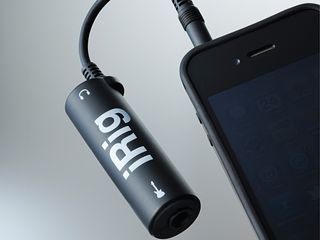
IK Multimedia iRig (£29)
Simply plugging into your iOS device’s headphone socket via its attached lead, the iRig is IK Multimedia’s companion to its iOS versions of the wildly successful AmpliTube modelling software.
It couldn’t be easier to use – just plug your guitar into one end of the cylindrical device, your headphones into the other, and off you go.
In Use
While the iRig inputs a decent enough signal, be aware that the unit’s passive circuitry combined with the input and output being in close proximity is a recipe for crosstalk that can result in feedback. This becomes most apparent when using high-gain models in your amp sims, necessitating setting the controls for lower output levels to stop any squealing.
Verdict
Altogether the device with the most plug-in-and-play simplicity in our round-up. The iRig does the job if you’re looking for a cheap and cheerful way to connect a guitar to an iOS device. Also, it’s either this or the Peavey if you want to use it with AmpliTube.
The Bottom Line
We like: Compact; inexpensive; simple to use
We dislike: The proximity of the input and output means it’s prone to feedback
3 out of 5
Click here to listen to a full song recorded using the iRig and AmpliTube's multitrack recorder
Click here to listen to an audio demo of AmpliTube Fender for iOS
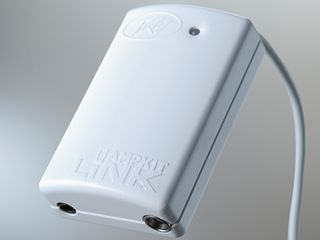
Peavey Ampkit Link (£31)
The only device of the six on test to require batteries (a pair of AAAs), the Ampkit Link is made by Peavey in conjunction with Agile Partners – a developer that produces the Ampkit app.
It connects via the headphone socket through its attached cable – guitar and headphones both plug into the same end of the unit’s plastic body.
In Use
The Ampkit Link is very similar to the iRig, but Peavey says that the fact that it is powered virtually eliminates any feedback when using headphones. In practice we found this to not be the case, although it offers some advantage in that the onset of feedback comes later than with the iRig as the gain is turned up.
One thing to be aware of though is that it doesn’t work with non-standard or ribbed 1/4-inch jacks so you may need to change your leads to use it.
Verdict
Like the iRig, it’s an inexpensive choice (if you disregard the ongoing cost of battery replacement) and it works with AmpliTube too.
The Bottom Line
We like: Compact; affordable
We dislike: Needs batteries; doesn’t work with with non-standard or ribbed standard jacks; prone to feedback
3 out of 5
Click here to hear Ampkit Link put through its paces by Total Guitar
Click here to read the Future Music review of Ampkit and Ampkit Link
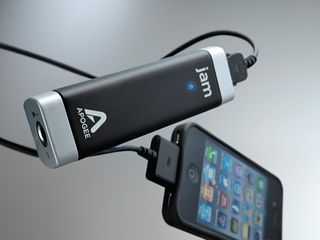
Apogee JAM (£90)
Apogee is a heavyweight in professional analogue/ digital audio conversion and the JAM is the only input device in this group that has its own onboard conversion – converting your guitar signal to digital before it reaches your iOS device’s dock.
It can also work when plugged directly into a Apple Mac computer using the supplied USB cable.
In Use
The JAM has an input gain control allied to a multi-colour LED, letting you dial in just the right amount of gain for your guitar.
The sound quality is excellent as the converters do their work and the JAM outputs a pristine signal with no apparent noise for quality recording and for using your amp sims to full advantage without the need for any significant tweaking.
Verdict
The JAM is more expensive than the other pocket-sized converters (though it is much cheaper for any US readers…) but if you’re looking for easy portability alongside excellent signal quality with no feedback issues, it’s the way to go.
The Bottom Line
We like: Compact size; quality A/D conversion; can be used with a Mac
We dislike: It only costs $99 in the USA!
4.5 out of 5
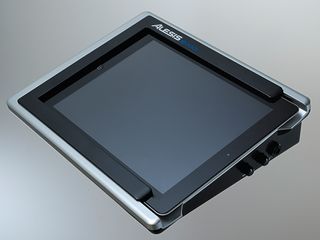
Alesis iO Dock (£139)
The iO Dock sits on your desk like a portastudiostyle device and houses your iPad or iPad 2 at a practical working angle.
It has socketry on its back and sides, offering all the connectivity you’d need to utilise recording apps and software synths, as well as guitar-related apps.
In Use
With input gain controls, volume knobs for main outputs and headphones, Hi-Z guitar input, footswitch jack and a direct monitoring facility, the iO Dock gives you everything that you need to interface a guitar or microphone with the iPad with a minimum of fuss. It simultaneously charges your tablet too – bonus.
Verdict
The iO Dock offers practicality of the first order, not just for your guitar apps but also with MIDI sockets, a connection for a larger monitor and the possibility of adding, say, punch-in recording via footswitch to apps that support it.
If you don’t intend to stray too far from mains power this is a brilliant idea, well executed. Sensibly priced, too.
The Bottom Line
We like: Comprehensive connectivity; direct input monitoring; hardware knobs
We dislike: Mains power means it’s not very portable
4.5 out of 5
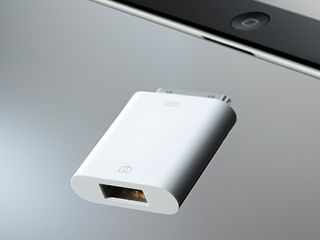
Apple Camera Connection Kit (£25)
Apple’s Camera Connection Kit offers two items that connect to the dock. One of them reads SD cards, but the other one allows you plug in a USB cable, letting you send a signal from an audio interface into the iPad.
In Use
Apple does not officially support using the Camera Connection Kit in this way, but you should get results as long as you have a USB audio interface that is class-compliant (ie works without its own drivers in OS X) and either requires less than 200mA of power, or has its own supply.
Verdict
At its asking price, the Camera Connection Kit is the least expensive in the round up, although it does have to be paired with another device. Still, it could be the practical budget choice – if you don’t need pocket-sized portability and already have a compatible audio interface, why buy another? Just connect it with one of these, and you can stick your photos on your iPad too!
The Bottom Line
We like: Compact; lets you use an existing USB audio interface; inexpensive
We dislike: Won’t work with all audio interfaces
3 out of 5
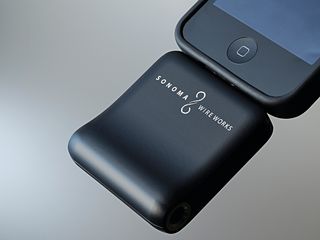
Sonoma Wire Works GuitarJack ($49)
Sonoma Wire Works has a new version of GuitarJack that will work with iPads and newer iPhones in the pipeline, but this version only works with the iPhone 3G, iPhone 3GS and the second and third generation iPod touch.
However, in anticipation of the new product, the asking price has been reduced to a bargain $49 from the original $99.
In Use
Solidly built and connecting via the dock, the GuitarJack has two inputs (1/4-inch mono and 1/8-inch stereo) that can be used simultaneously to record both an instrument and mic.
Various input options are available via a software control panel that offers, among other things, high or low impedance for the 1/4-inch input and adjustment of the analog input level before it is digitised.
Verdict
GuitarJack works well and will reward you with good quality sounds, provided you have a compatible device. If you don’t you’ll have to look elsewhere, or wait for the new model.
The Bottom Line
We like: Compact size; solidly engineered
We dislike: This version is only compatible with older iPhone and iPod models
3 out of 5
Click here to read much more about mobile music making with iOS on MusicRadar
Trevor Curwen has played guitar for several decades – he's also mimed it on the UK's Top of the Pops. Much of his working life, though, has been spent behind the mixing desk, during which time he has built up a solid collection of the guitars, amps and pedals needed to cover just about any studio session. He writes pedal reviews for Guitarist and has contributed to Total Guitar, MusicRadar and Future Music among others.
Most Popular









